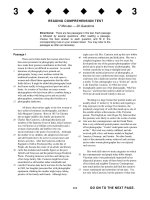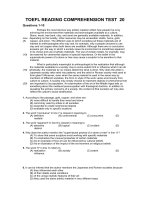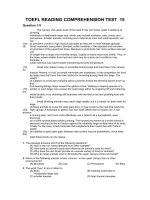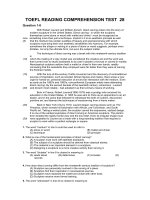TOEFL READING COMPREHENSION TEST 19
Bạn đang xem bản rút gọn của tài liệu. Xem và tải ngay bản đầy đủ của tài liệu tại đây (78.91 KB, 8 trang )
TOEFL READING COMPREHENSION TEST 19
Questions 1-9
The term "Hudson River school" was applied to the foremost representatives of
nineteenth-century North American landscape painting. Apparently unknown during
the golden days of the American landscape movement, which began around 1850 and
Line lasted until the late 1860's, the Hudson River school seems to have emerged in the
(5) 1870's as a direct result of the struggle between the old and the new generations of
artists, each to assert its own style as the representative American art. The older
painters, most of whom were born before 1835, practiced in a mode often self-taught
and monopolized by landscape subject matter and were securely established in and
fostered by the reigning American art organization, the National Academy of Design.
(10) The younger painters returning home from training in Europe worked more with figural
subject matter and in a bold and impressionistic technique; their prospects for
patronage in their own country were uncertain, and they sought to attract it by attaining
academic recognition in New York. One of the results of the conflict between the two
factions was that what in previous years had been referred to as the "American",
(15) "native", or, occasionally, "New York" school – the most representative school of
American art in any genre – had by 1890 become firmly established in the minds of
critics and public alike as the Hudson River school.
The sobriquet was first applied around 1879. While it was not intended as
flattering,
it was hardly inappropriate. The Academicians at whom it was aimed had worked and
(20) socialized in New York, the Hudson's port city, and had painted the river and its shores
with varying frequency. Most important, perhaps, was that they had all maintained with
a certain fidelity a manner of technique and composition consistent with those of
America's first popular landscape artist, Thomas Cole, who built a career painting the
Catskill Mountain scenery bordering the Hudson River. A possible implication in the
(25) term applied to the group of landscapists was that many of them had, like Cole, lived
on or near the banks of the Hudson. Further, the river had long served as the principal
route to other sketching grounds favored by the Academicians, particularly the
Adirondacks and the mountains of Vermont and New Hampshire.
1. What does the passage mainly discuss?
(A) The National Academy of Design
(B) Paintings that featured the Hudson River
(C) North American landscape paintings
(D) The training of American artists in European academies
2. Before 1870, what was considered the most representative kind of American painting?
(A) Figural painting (B) Landscape painting
(C) Impressionistic painting (D) Historical painting
3. The word "struggle" in line 5 is closest in meaning to
(A) connection (B) distance (C) communication (D)
competition
4. The word "monopolized" in line 8 is closest in meaning to
(A) alarmed (B) dominated (C) repelled (D)
pursued
5. According to the passage, what was the function of the National Academy of Design for the
painters born before 1835?
(A) It mediated conflicts between artists.
(B) It supervised the incorporation of new artistic techniques.
(C) It determined which subjects were appropriate.
(D) It supported their growth and development.
6. The word "it" in line 12 refers to
(A) matter (B) technique (C) patronage (D)
country
7. The word "factions" in line 14 is closest in meaning to
(A) sides (B) people (C) cities (D)
images
8. The word "flattering" in line 18 is closest in meaning to
(A) expressive (B) serious (C) complimentary (D) flashy
9. Where did the younger generation of painters receive its artistic training?
(A) In Europe (B) In the Adirondacks
(C) In Vermont (D) In New Hampshire
Questions 10-22
Television has transformed politics in the United States by changing the way in
which information is disseminated, by altering political campaigns, and by changing
citizen's patterns of response to politics. By giving citizens independent access to the
Line candidates, television diminished the role of the political party in the selection of the
(5) major party candidates. By centering politics on the person of the candidate, television
accelerated the citizen's focus on character rather than issues.
Television has altered the forms of political communication as well. The
messages
on which most of us rely are briefer than they once were. The stump speech, a political
speech given by traveling politicians and lasting 3/2 to 2 hours, which characterized
(10) nineteenth-century political discourse, has given way to the 30-second advertisement
and the 10 second "sound bite" in broadcast news. Increasingly the audience for
speeches is not that standing in front of the politician but rather the viewing audience
who will hear and see a snippet of the speech on the news.
In these abbreviated forms, much of what constituted the traditional political
(15) discourse of earlier ages has been lost. In 15 or 30 seconds, a speaker cannot
establish
the historical context that shaped the issue in question, cannot detail the probable
causes of the problem, and cannot examine alternative proposals to argue that one is
preferable to others. In snippets, politicians assert but do not argue.
Because television is an intimate medium, speaking through it require a changed
(20) political style that was more conversational, personal, and visual than that of the
oldstyle
stump speech. Reliance on television means that increasingly our political world
contains memorable pictures rather than memorable words. Schools teach us to
analyze
words and print. However, in a word in which politics is increasingly visual, informed
citizenship requires a new set of skills.
(25) Recognizing the power of television's pictures, politicians craft televisual, staged
events, called pseudo-event, designed to attract media coverage. Much of the political
activity we see on television news has been crafted by politicians, their speechwriters,
and their public relations advisers for televised consumption. Sound bites in news and
answers to questions in debates increasingly sound like advertisements.
10. What is the main point of the passage?
(A) Citizens in the United States are now more informed about political issues because
of television coverage.
(B) Citizens in the United States prefer to see politicians on television instead of in
person.
(C) Politics in the United States has become substantially more controversial since the
introduction of television.
(D) Politics in the United States has been significantly changed by television.
11. The word "disseminated" in line 2 is closest in meaning to
(A) analyzed (B) discussed (C) spread (D) stored
12. It can be inferred that before the introduction of television, political parties
(A) had more influence over the selection of political candidates
(B) spent more money to promote their political candidates
(C) attracted more members
(D) received more money
13. The word "accelerated" in line 6 is closest in meaning to
(A) allowed (B) increased (C) required (D)
started
14. The author mentions the "stump speech" in line 8 as an example of
(A) an event created by politicians to attract media attention
(B) an interactive discussion between two politicians
(C) a kind of political presentation typical of the nineteenth century
(D) a style of speech common to televised political events
15. The phrase "given way to" in line 10 is closest in meaning to
(A) added interest to (B) modified
(C) imitated (D) been replaced by
16. The word "that" in line 12 refers to
(A) audience (B) broadcast news
(C) politician (D) advertisement
17. According to the passage, as compared with televised speeches, traditional political
discourse was more successful at
(A) allowing news coverage of political candidates
(B) placing political issues within a historical context
(C) making politics seem more intimate to citizens
(D) providing detailed information about a candidates private behavior
18. The author states that "politicians assert but do not argue" (line 18) in order to suggest
that politicians
(A) make claims without providing reasons for the claims
(B) take stronger positions on issues than in the past
(C) enjoy explaining the issue to broadcasters
(D) dislike having to explain their own positions on issues to citizens
19. The word "Reliance" in line 21 is closest in meaning to
(A) abundance (B) clarification (C) dependence (D)
information
20. The purpose of paragraph 4 is to suggest that
(A) politicians will need to learn to become more personal when meeting citizens
(B) politicians who are considered very attractive are favored by citizens over politicians
who are less attractive
(C) citizens tend to favor a politician who analyzed the issue over one who does not
(D) citizens will need to learn how to evaluate visual political images in order to become
better informed
21. According to paragraph 5, staged political events are created so that politicians can
(A) create more time to discuss political issues
(B) obtain more television coverage for themselves
(C) spend more time talking to citizens in person
(D) engages in debates with their opponents
22. Which of the following statements is supported by the passage?
(A) Political presentations today are more like advertisements than in the past.
(B) Politicians today tend to be more familiar with the views of citizens than in the past.
(C) Citizens today are less informed about a politician's character than in the past.
(D) Political speeches today focus more on details about issues than in the past.
Questions 23-33
The spectacular aurora light displays that appear in Earth's atmosphere around
the
north and south magnetic poles were once mysterious phenomena. Now, scientists
have
data from satellites and ground-based observations from which we know that the
Line aurora brilliance is an immense electrical discharge similar to that occurring in a
(5) neon sign.
To understand the cause of auroras, first picture the Earth enclosed by its
magnetosphere, a huge region created by the Earth's magnetic field. Outside the
magnetosphere, blasting toward the earth is the solar wind, a swiftly moving plasma of
ionized gases with its own magnetic filed. Charged particles in this solar wind speed
(10) earthward along the solar wind's magnetic lines of force with a spiraling motion. The
Earth's magnetosphere is a barrier to the solar winds, and forces the charged particles
of
the solar wind to flow around the magnetosphere itself. But in the polar regions, the
magnetic lines of force of the Earth and of the solar wind bunch together. Here many of
the
solar wind's charged particles break through the magnetosphere and enter Earth's
(15) magnetic field. They then spiral back and forth between the Earth's magnetic poles
very rapidly. In the polar regions, electrons from the solar wind ionize and excite the
atoms and molecules of the upper atmosphere, causing them to emit aurora radiations
of visible light.
The colors of an aurora depend on the atoms emitting them. The dominant
greenish
(20) white light comes from low energy excitation of oxygen atoms. During huge magnetic
storms oxygen atoms also undergo high energy excitation and emit a crimson light.
Excited nitrogen atoms contribute bands of color varying from blue to violet.
Viewed from outer space, auroras can be seen as dimly glowing belts wrapped
around each of the Earth's magnetic poles. Each aurora hangs like a curtain of light
(25) stretching over the polar regions and into the higher latitudes. When the solar flares
that result in magnetic storms and aurora activity are very intense, aurora displays
may extend as far as the southern regions of the United States.
Studies of auroras have given physicists new information about the behavior of
plasmas, which has helped to explain the nature of outer space and is being applied in
(30) attempts to harness energy from the fusion of atoms.
23. What does the passage mainly discuss?
(A) The methods used to observe auroras from outer space
(B) The formation and appearance of auroras around the Earth's poles
(C) The factors that cause the variety of colors in auroras
(D) The periodic variation in the display of auroras
24. The word "phenomena" in line 2 is closest in meaning to
(A) ideas (B) stars (C) events (D) colors
25. The word "picture" in line 6 is closest in meaning to
(A) frame (B) imagine (C) describe (D)
explain
26. The passage describes the magnetosphere as a barrier (line 11) because
(A) its position makes it difficult to be observed from Earth
(B) it prevents particles from the solar wind from easily entering Earth's atmosphere
(C) it increases the speed of particles from the solar wind
(D) it is strongest in the polar regions
27. The word "them" in line 17 refers to
(A) polar regions (B) electrons
(C) atoms and molecules (D) aurora radiations
28. According to the passage, which color appears most frequently in an aurora display?
(A) Greenish-white (B) Crimson (C) Blue (D) Violet
29. The word "emit" in line 21 is closest in meaning to
(A) change from (B) connect with (C) add to (D) give
off
30. The word "glowing" in line 23 is closest in meaning to
(A) shining (B) moving (C) charging (D)
hanging
31. Auroras may be seen in the southern regions of the United Sates when
(A) magnetic storms do not affect Earth
(B) solar flares are very intense
(C) the speed of the solar wind is reduced
(D) the excitation of atoms is low
32. The passage supports which of the following statements about scientists' understanding
of auroras?
(A) Before advances in technology, including satellites, scientists knew little about
auroras.
(B) New knowledge about the fusion of atoms allowed scientists to learn more about
auroras.
(C) Scientists cannot explain the cause of the different colors in auroras.
(D) Until scientists learn more about plasma physics, little knowledge about auroras will
be available.
33. Which of the following terms is defined in the passage?
(A) "magnetosphere" (line 7) (B) "electrons" (line 16)
(C) "ionize" (line 16) (D) "fusion" (line 30)
Questions 34-44
Matching the influx of foreign immigrants into the larger cities of the United
States
during the late nineteenth century was a domestic migration, from town and farm to
city, within the United States. The country had been overwhelmingly rural at the
Line beginning of the century, with less than 5 percent of Americans living in large towns
(5) or cities. The proportion of urban population began to grow remarkably after 1840,
increasing from 11 percent that year to 28 percent by 1880 and to 46 percent by 1900.
A country with only 6 cities boasting a population of more than 8,000 in 1800 had
become one with 545 such cities in 1900. of these, 26 had a population of more than
100,000 including 3 that held more than a million people. Much of the migration
(10) producing an urban society came from smaller towns within the United States, but the
combination of new immigrants and old American "settlers" on America's "urban
frontier" in the late nineteenth century proved extraordinary.
The growth of cities and the process of industrialization fed on each other. The
agricultural revolution stimulated many in the countryside to seek a new life in the city
(15) and made it possible for fewer farmers to feed the large concentrations of people
needed to provide a workforce for growing numbers of factories. Cities also provided
ready and convenient markets for the products of industry, and huge contracts in
transportation and construction-as well as the expanded market in consumer
goods-allowed continued growth of the urban sector of the overall economy of the
(20) Untied States.
Technological developments further stimulated the process of urbanization. One
example is the Bessemer converter (an industrial process for manufacturing steel),
which provided steel girders for the construction of skyscrapers. The refining of crude
oil into kerosene, and later the development of electric lighting as well as of the
(25) telephone, brought additional comforts to urban areas that were unavailable to rural
Americans and helped attract many of them from the farms into the cities. In every era
the lure of the city included a major psychological element for country people; the
bustle and social interaction of urban life seemed particularly intriguing to those raised
in rural isolation.
34. What aspects of the United States in the nineteenth century does the passage mainly
discuss?
(A) Technological developments
(B) The impact of foreign immigrants on cities
(C) Standards of living
(D) The relationship between industrialization and urbanization
35. The word "influx" in line 1 is closest in meaning to
(A) working (B) processing (C) arrival (D)
attraction
36. The paragraph preceding the passage most probably discuss
(A) foreign immigration (B) rural life
(C) the agricultural revolution (D) famous cities of the twentieth
century
37. What proportion of population of the United States was urban in 1900?
(A) Five percent (B) Eleven percent
(C) Twenty-eight percent (D) Forty-six percent
38. The word "extraordinary" in line 12 is closet in meaning to
(A) expensive (B) exceptional (C) supreme (D)
necessary
39. The phrase "each other" in line 13 refers to
(A) foreign immigrants and domestic migrants (B) farms and small towns
(C) growth of cities and industrialization (D) industry and transportation
40. The word "stimulated" in line 14 is closest in meaning to
(A) forced (B) prepared (C) limited (D)
motivated
41. Why does the author mention "electric lighting" and "the telephone" in lines 24-25?
(A) They contributed to the agricultural revolution
(B) They are examples of the conveniences of city life
(C) They were developed by the same individual.
(D) They were products of the Bessemer converter.
42. The word "them" in line 26 refers to
(A) urban areas (B) rural Americans (C) farms (D) cities
43. The word "era" in line 26 is closest in meaning to
(A) period of time (B) location (C) action (D) unique
situation
44. The word "intriguing" in line 28 is closest in meaning to
(A) profitable (B) attractive (C) comfortable (D)
challenging
Questions 45-50
The nervous system of vertebrates is characterized by a hollow, dorsal nerve
cord
that ends in the head region as an enlargement, the brain. Even in its most primitive
form this cord and its attached nerves are the result of evolutionary specialization,
Line and their further evolution from lower to higher vertebrate classes is a process that
(5) is far from fully understood. Nevertheless, the basic arrangements are similar in all
vertebrates, and the study of lower animals gives insight into the form and structure
of the nervous system of higher animals. Moreover, for any species, the study of the
embryological development of the nervous system is indispensable for an
understanding
of adult morphology.
(10) In any vertebrate two chief parts of the nervous system may be distinguished.
These
are the central nervous system (the nerve cord mentions above), consisting of the
brain and spinal cord, and the peripheral nervous system, consisting of the cranial,
spinal, and peripheral nerves, together with their motor and sensory endings. The term
"autonomic nervous system" refers to the parts of the central and peripheral systems
(15) that supply and regulate the activity of cardiac muscle, smooth muscle, and many
glands.
The nervous system is composed of many millions of nerve and glial cells,
together
with blood vessels and a small amount of connective tissue. The nerve cells, or
"neurons", are characterized by many processes and are specialized in that they
exhibit
(20) to a great degree the phenomena of irritability and conductivity. The glial cells of the
central nervous system are supporting cells collectively termed "neuroglia". They are
characterized by short processes that have special relationships to neurons, blood
vessels, and connective tissue. The comparable cells in the peripheral nervous system
are termed "neurilemmal" cells.
45. What does the passage mainly discuss?
(A) The parts of a neuron (B) The structure of animals' nerve
(C) The nervous system of vertebrates (D) The development of the brain
46. According to the passage, the nerve cord of vertebrates is
(A) large (B) hollow (C) primitive (D)
embryological
47. The author implies that a careful investigation of a biological structure in an embryo may
(A) Improved research of the same structure in other species
(B) A better understanding of the fully developed structure
(C) Discovering ways in which poor development can be corrected
(D) A method by which scientists can document the various stages of development
48. The two main parts of the central nervous system are the brain and the
(A) sensory endings (B) cranial nerve (C) spinal cord (D)
peripheral nerves
49. All of the following are described as being controlled by the autonomic nervous system
EXCEPT
(A) connective tissue (B) cardiac muscle (C) glandular activity (D)
smooth muscle
50. In what lines does the author identify certain characteristic of nerve cells?
(A) 1-2 (B) 10-13 (C









